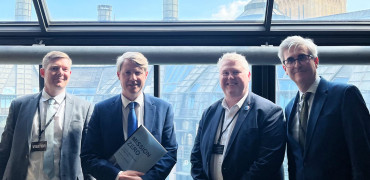As the UK strides towards its ambitious Net Zero Carbon goal by 2050, the spotlight turns to the buildings we live and work in - a significant contributor to the nation's carbon footprint.
Central to achieving this goal are the M&E contractors, whose decisions and expertise in heating, ventilating, and air conditioning systems play a pivotal role in shaping a sustainable future.
It’s important to consider the environmental impact of HVAC systems.
Two years ago, the Climate Change Committee's (CCC) Sixth Carbon Budget laid the groundwork, highlighting the need to focus on fluorinated gases (F gases) in air conditioning systems.
F gases, particularly hydrofluorocarbons (HFCs), are potent greenhouse gases, with some variants having a global warming potential (GWP) thousands of times greater than carbon dioxide.
The UK, aligning with EU regulations, has been actively reducing the use of high GWP gases, setting a decreasing cap on HFC usage. Recently, the EU has set a much steeper course to reduce high-GWP refrigerants on the market, and we should expect the UK to follow the same route in the next few years.
M&E contractors hold a critical position in our transition to low-carbon buildings
Lower GWP refrigerants
Transitioning to low-GWP refrigerants is an essential step in reducing the carbon footprint of our buildings. This regulatory landscape has already nudged the UK's air conditioning market towards low-GWP refrigerants.
For example, R22, a refrigerant with a GWP of around 1,800, was completely phased out by 2015. Mitsubishi Electric's response to these changes includes developing R32 refrigerant (GWP of 675) systems and hybrid systems that reduce R32 usage by incorporating water mediums.
Moreover, the rise of hydrofluoro-olefins (HFOs) like R1234ze (GWP of 7) and R1234yf (GWP of 4) marks a significant step towards environmentally friendly solutions. Mitsubishi Electric’s Climaveneta brand, for instance, uses R1234ze in its chillers, tailored to the properties of this low-impact refrigerant.
Acceptable to tenants and owners
But it’s not just government policy driving change. Corporate responsibility policies are having an impact on what owners and tenants find acceptable for their buildings.
The growing number of businesses committing to reduce their carbon footprint is another compelling force. This has led to an increased scrutiny of F gases in HVAC systems. As clients and consultants seek sustainable options, M&E contractors are at the forefront, offering solutions that align with evolving market needs and environmental responsibilities.
Embracing renewable technologies, the Ecodan QAHV heat pump, using CO2 (GWP of 1) as a refrigerant, represents a leap in sustainable HVAC technology. Producing hot water up to 90°C, it’s an example of innovative engineering developments helping M&E contractors meet the environmental goals of their clients.
An important role for M&E
As designers and installers of HVAC systems, M&E contractors hold a critical position in our transition to low-carbon buildings. Their decisions in equipment selection, installation methodologies, and maintenance programmes significantly impact the environmental footprint of both new and existing buildings.
The shift to low-GWP refrigerants is not just regulatory compliance but a proactive step towards sustainability.
While the shift to low-GWP refrigerants is crucial, M&E contractors must also consider other factors that fall within their remit.
Energy-efficient design, proper installation, and regular maintenance of HVAC systems play a vital role in reducing the overall carbon footprint of buildings.
This includes embracing smart technology and automation to optimise system performance and reduce energy consumption.
Staying abreast
Achieving Net Zero requires collaboration across all sectors. M&E contractors, working closely with manufacturers, consultants, and clients, can drive innovation and implement solutions that meet current needs and anticipate future regulatory changes and environmental challenges.
As the UK continues its journey towards Net Zero Carbon, it's imperative for M&E contractors to stay abreast of regulations and innovations in low-GWP cooling and heating technologies. The choices made today will not only ensure compliance but also provide robust, energy-efficient, and long-term sustainable solutions for buildings across the UK.
In this collective effort, every decision and action taken by M&E professionals contributes significantly to the larger goal of reducing our national carbon footprint, ultimately shaping a greener, more sustainable future for all.
Dave Archer is Business Manager - Influenced Sales




